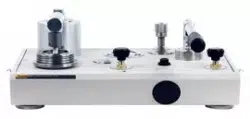Loading ...
Loading ...
Loading ...

P3000 Series
Users Manual
3-2
8. Depressurize the system by SLOWLY opening the Exhaust valve, as sudden
depressurization will cause the weight stack to fall quickly, which may damage the
piston assembly.
9. Remove the weights from the piston.
Single PCU Models — Vacuum
1. Ensure that both Inlet and Exhaust valves are closed.
2. Select the required weights and stack them on the piston assembly. The vacuum
measured is the sum of the weights plus the piston/weight carrier. (The weights can
be passed over the weight carrier if held at a slight angle).
3. Use the handpump (if fitted) to generate pressure until the piston floats i.e. not
touching the top or bottom travel limits.
Note
Handpump use: Slow down-strokes will only partially contribute vacuum,
for higher vacuum, a faster down-stroke is required. The handpump will
generate approximately 75% vacuum (depending upon local atmospheric
conditions), above this range, an external vacuum supply will be required.
Alternatively, if connected to an external supply, SLOWLY open and close
Inlet valve until piston floats. If piston is over-pressurized (piston against
top travel limit) then reduce pressure by SLOWLY opening and closing
Exhaust valve until the piston floats.
4. Gently rotate the weight stack clockwise, such that it is turning between
approximately 10 and 60 rpm. Avoid side-loads when turning the weights by placing
the palms of the hands on either side and “rolling” the stack by pulling in opposite
directions, see Figure 3-1. DO NOT rotate weights when the piston is
against the top or bottom limits of travel.
5. Allow a few moments for the system to stabilize before taking any readings,
especially after large changes in system pressure.
6. For the next, higher calibration point, repeat from step 2 above.
7. To measure reducing vacuum, remove the necessary weights, and by opening and
closing the Exhaust valve, SLOWLY reduce the system pressure until the piston
floats, then rotate clockwise as above.
8. Release vacuum by SLOWLY opening the Exhaust valve, as sudden depressurization
will cause the weight stack to fall quickly, which may damage the piston assembly.
9. Remove the weights from the piston.
Dual PCU (Pressure & Vacuum) Models
1. Select Pressure or Vacuum Mode by turning the system selector valve on the front of
the instrument, 1/4 turn counter-clockwise for Pressure, 1/4 turn clockwise for
vacuum. The selector valve automatically vents the system as it changes from
pressure to vacuum mode to prevent damage to sensitive vacuum equipment. During
the changeover, the operator may hear gas venting harmlessly inside the instrument
case as this occurs.
2. If the instrument is fitted with the optional handpump, ensure that the handpump
selector valve is also turned to the appropriate mode, 1/4 turn clockwise for Pressure
(handle pointing backward towards the pressure PCU) or 1/4 turn counter-clockwise
for Vacuum (handle pointing frontward towards the vacuum PCU).
1.888.610.7664 sales@GlobalTestSupply.com
Fluke-Direct.com
Loading ...
Loading ...
Loading ...
